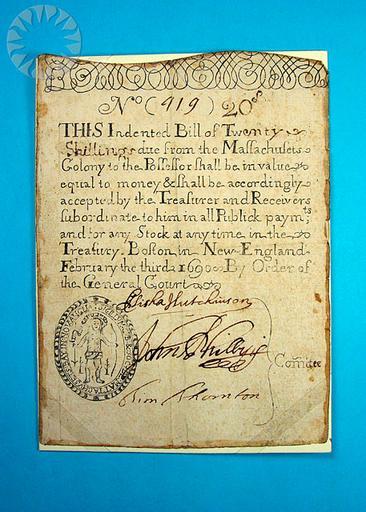MAKE A MEME
View Large Image

| View Original: | Massachusetts,_20_Shillings,_1690.jpg (457x640) | |||
| Download: | Original | Medium | Small | Thumb |
| Courtesy of: | www.flickr.com | More Like This | ||
| Keywords: legendary coins legendarycoins numismatics money smithsonian probably public domain probablypublicdomain SI Neg. 2005-27378. Date: 9/1/2005...Called upon by the British government to help fight the French in Canada in 1689, Massachusetts authorities were hard-put to comply, because official money was unavailable. The Hull/Sanderson mint, which had created Pine Tree Shillings and other coins, had been closed on Crown orders years before, and all coinage was now in extremely short supply. .Then someone had an idea: Why not issue paper certificates to pay for the supplies and troops that Massachusetts was expected to contribute? The Crown had promised to reimburse the colony, in coinage, at war's end. The experiment was tried, and it worked. The first government-issued paper money in the entire Western world had made its appearance unexpectedly in Massachusetts. .Since these notes could eventually be redeemed for coinage - were in fact as good as gold or silver - another unknown functionary had an epochal idea: why not leave them in circulation? After all, everyone accepted their status as "real" money, and the need for them was great. So it was done. Colonial authorities elsewhere watched, and when the Crown did not stop the experiment in the Bay Colony, other colonies decided to begin issuing paper currency of their own. .Paper's popularity spread, and colonial America became dependent upon it. But paper was vulnerable to counterfeiting, or, in this case, to tampering. No twenty-shilling notes were actually issued by Massachusetts in 1690. Yet someone skilled with a pen thought there ought to be one, and proceeded to create it, altering the original denomination of two shillings sixpence. ..Credit: Tom Mulvaney (Smithsonian Institution) SI Neg. 2005-27378. Date: 9/1/2005...Called upon by the British government to help fight the French in Canada in 1689, Massachusetts authorities were hard-put to comply, because official money was unavailable. The Hull/Sanderson mint, which had created Pine Tree Shillings and other coins, had been closed on Crown orders years before, and all coinage was now in extremely short supply. .Then someone had an idea: Why not issue paper certificates to pay for the supplies and troops that Massachusetts was expected to contribute? The Crown had promised to reimburse the colony, in coinage, at war's end. The experiment was tried, and it worked. The first government-issued paper money in the entire Western world had made its appearance unexpectedly in Massachusetts. .Since these notes could eventually be redeemed for coinage - were in fact as good as gold or silver - another unknown functionary had an epochal idea: why not leave them in circulation? After all, everyone accepted their status as "real" money, and the need for them was great. So it was done. Colonial authorities elsewhere watched, and when the Crown did not stop the experiment in the Bay Colony, other colonies decided to begin issuing paper currency of their own. .Paper's popularity spread, and colonial America became dependent upon it. But paper was vulnerable to counterfeiting, or, in this case, to tampering. No twenty-shilling notes were actually issued by Massachusetts in 1690. Yet someone skilled with a pen thought there ought to be one, and proceeded to create it, altering the original denomination of two shillings sixpence. ..Credit: Tom Mulvaney (Smithsonian Institution) | ||||